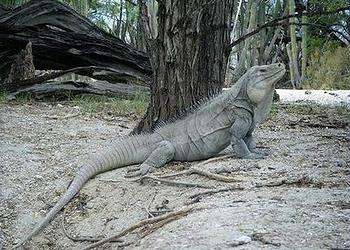
SANTO DOMINGO, Dominican Republic, July 22, 2013 (ENS) – A biological reserve set aside by the Dominican government just four years ago to protect rare birds and iguanas is now being bulldozed for an agricultural settlement.
On the afternoon of July 16, the Dominican Agrarian Institute, a government agency, moved bulldozers and other heavy equipment into place to start dismantling part of the protected area called Loma Charco Azul Biological Reserve.

The action is one of the special projects of the Dominican Agrarian Institute in response to the flooding of Lake Enriquillo in June that forced hundreds of families from their homes.
But the area is arid and there is no irrigation in place, making it difficult to farm. Nevertheless, about 105 hectares are slated for immediate clearing.
Grupo Jaragua, which is the BirdLife affiliate in the Dominican Republic, and local residents of Duvergé Township, are in emergency alert trying to stop the bulldozers, notifying the media and other environmental groups of their deep concern over this sudden government-backed intrusion on both conservation practice and environmental law.
The National Institute of Lawyers for the Protection of the Environment is preparing legal action against this measure, as they claim it contravenes the National Environment Law 64-00, and sets a dangerous precedent for all protected areas of the Dominican Republic.
The National Academy of Sciences and the Environmental Commission of the Autonomous University of Santo Domingo have also expressed concern.
Grupo Jaragua is in constant communication with the Environmental Attorney’s Office to attempt to halt the forest clearings. Yet area of roughly 7.2 hectares was destroyed early in the morning of July 17.
The Dominican Agrarian Institute, responsible for the destruction, has shown a permit for this activity signed by the Minister of the Environment Dr. Bautista Rojas Gómez.
The Loma Charco Azul Biological Reserve is located in the Sierra de Bahoruco mountain range in southwest Dominican Republic. The reserve covers 17,400 hectares and was established as a result of the partnership between Grupo Jaragua, American Bird Conservancy, the Dominican government and the Dominican Environmental Consortium.
The importance of the area for conservation was recognized by former President Leonel Fernández, who granted it the status of Reserve in 2009. This was a major achievement for Grupo Jaragua, which had been lobbying for protection of the area.

Serving a double function as habitat for rare birds and animals and as a connecting wildlife corridor, the Loma Charco Azul Biological Reserve is located within the larger Jaragua-Bahoruco-Enriquillo Biosphere Reserve ratified by UNESCO.
Also part of the Sierra de Bahoruco Important Bird Area, the reserve provides essential habitat for 32 of the 34 Hispaniola restricted-range birds, 14 threatened bird species and over 30 neotropical migratory birds.
The impacted area is the largest portion of remaining habitat for the Ricord’s Iguana, Cyclura ricordii, found only in the southwest of the Dominican Republic and listed as Critically Endangered on the IUCN Red List of Threatened Species maintained by the International Union for the Conservation of Nature.
The hills of Loma Charco Azul are also habitat for the Endangered bay-breasted cuckoo, Coccyzus rufigularis, an endemic bird with a very limited distribution in Hispaniola.
“As local media have done little to call attention to this matter, global attention might be necessary to increase pressure on the Dominican Agrarian Institute to put a stop to their destructive practices,” says Yntze van der Hoek, an ecologist and doctoral candidate with the City University of New York’s College of Staten Island, now a temporary resident of the Dominican Republic.
He told ENS, “Grupo Jaragua and their allies will need all the help they can get to fight for continued protection of one of Hispaniola’s key biodiversity hotspots.”
Copyright Environment News Service (ENS) 2013. All rights reserved.
© 2013, Environment News Service. All rights reserved. Content may be quoted only with proper attribution and a direct link to the original article. Full reproduction is prohibited.
